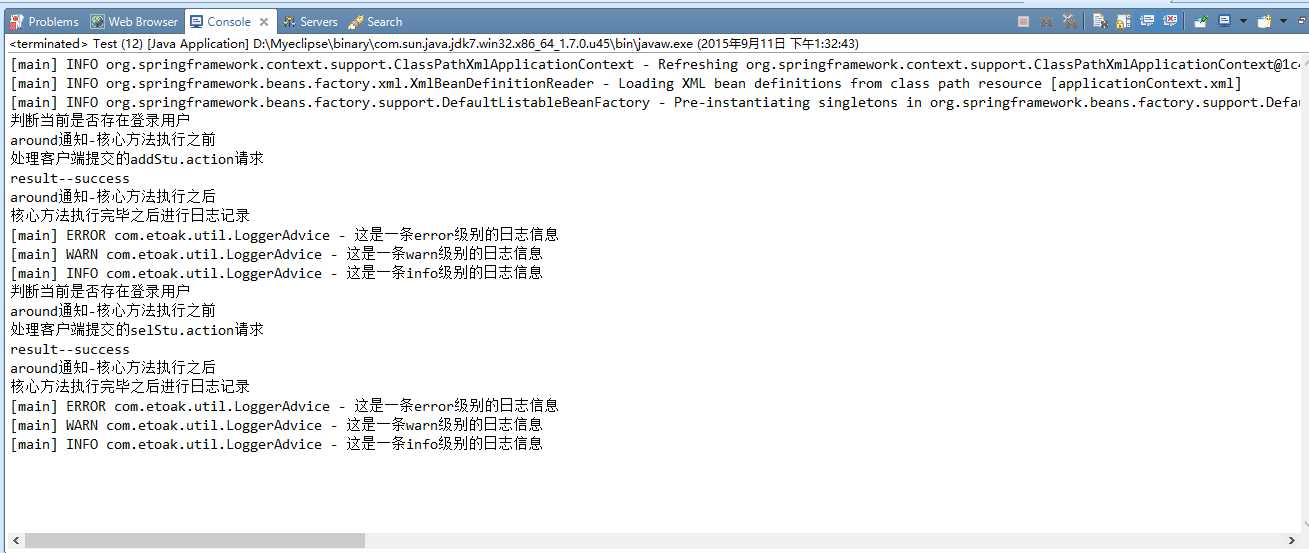标签:tar 切面 obj 返回 cut append 2.x 取消 bug
内容源自:AOP技术理解与使用
aop技术是面向切面编程思想,作为OOP(面向对象编程)的延续思想添加到企业开发中,用于弥补OOP开发过程中的缺陷而提出的编程思想。
AOP底层也是面向对象;只不过面向的不是普通的Object对象,而是特殊的AOP对象。AOP的关注点是组成系统的非核心通用服务模块(比如登录检查等),相对于普通对象,aop不需要通过继承、方法调用的方式来提供功能,只需要在xml文件中以引用的方式,将非核心服务功能引用给需要改功能的核心业务逻辑对象或方法中。最终实现对象的解耦。spring 中ioc技术实现了核心业务逻辑对象之间的解耦(如LoginAction与DaoImpl), aop技术实现的是核心业务逻辑对象与非核心通用服务之间的解耦(如LoginAction与LoginCheckInterceptor).
OOP的问题不存在于开发阶段,在开发阶段和首次测试阶段中,使用OOP是效率最高也是最简单的一种方式。OOP问题体现在软件开发完毕之后的二次测试阶段,软件修改完毕之后,需要对软件中修改的方法进行重新测试,之后才可以上线运行。这时测试的对象是当前修改的方法 以及 和该方法具有级联/依赖关系的所有的其他方法。这样做显然了延长二次测试周期。 而使用aop在二次测试时,因为他是配置在xml文件中的,所以并不需要测试相关的所有类。
我们使用一个例子来介绍下如何在spring中使用aop,
这里我们提供一个类StuAction,为这个类中的核心业务逻辑方法(addStu、delStu)添加登录检查的功能。
public class StuAction { public String addStu(){ System.out.println("处理客户端提交的addStu.action请求"); //int i = 1/0; return "success"; } public String delStu(){ System.out.println("处理客户端提交的selStu.action请求"); return "success"; } }
spring中的AOP技术提供了四种基本类型的通知:
这四种通知我们都来测试下:
注意:在测试athrows通知时把StuAction中的int i = 1/0;取消注释,我们创建一个异常来进行测试。
另外,after通知主要用来核心方法调用结束后输出日志,所以这里用到了log4j 。
// 定义一个实现MethodBeforeAdvice的通知类 - before通知 public class LoginCheckAdvice implements MethodBeforeAdvice { // 该方法会在核心方法执行之前自动执行 @Override public void before(Method arg0, Object[] arg1, Object arg2) throws Throwable { System.out.println("判断当前是否存在登录用户"); // 根据判断的结果决定是否执行后续的核心方法 } } // after通知 public class LoggerAdvice implements AfterReturningAdvice{ private static Logger logger = Logger.getLogger(LoggerAdvice.class); // 该方法会在核心方法执行完毕之后自动执行 @Override public void afterReturning(Object arg0, Method arg1, Object[] arg2, Object arg3) throws Throwable { // TODO Auto-generated method stub System.out.println("核心方法执行完毕之后进行日志记录"); // 记录一条日志信息 logger.error("这是一条error级别的日志信息"); logger.warn("这是一条warn级别的日志信息"); logger.info("这是一条info级别的日志信息"); logger.debug("这是一条debug级别的日志信息"); } } // around通知 public class AroundAdvice implements MethodInterceptor { @Override public Object invoke(MethodInvocation invocation) throws Throwable { //struts2 interceptor ActionInvocation调度者 System.out.println("around通知-核心方法执行之前"); Object result = invocation.proceed(); // 将请求的执行权限转交给核心业务逻辑方法 addStu/selStu // result - 核心方法的执行结果 addStu()/selStu() System.out.println("result--"+result); // success System.out.println("around通知-核心方法执行之后"); return result; } } // throws通知 public class ExceptionAdvice implements ThrowsAdvice { //该方法会在核心方法执行出现异常之后自动执行 public void afterThrowing(Method method, Object[] args, Object target, Exception ex){ System.out.println("核心方法执行出现异常了...异常信息"+ex.getMessage()); } }
log4j.properties
log4j.rootLogger=info,etoak1,etoak2 log4j.appender.etoak1=org.apache.log4j.ConsoleAppender log4j.appender.etoak1.layout=org.apache.log4j.TTCCLayout log4j.appender.etoak2=org.apache.log4j.FileAppender log4j.appender.etoak2.file=C://log4j.html log4j.appender.etoak2.layout=org.apache.log4j.HTMLLayout
好了,准备工作完毕,那我们如何在spring容器中配置aop呢?
重点的来了!
在applicationContext.xml中配置aop:
首先导入spring 中aop下所有包,log4j 包
<beans xmlns="http://www.springframework.org/schema/beans" xmlns:context="http://www.springframework.org/schema/context" xmlns:mvc="http://www.springframework.org/schema/mvc" xmlns:aop="http://www.springframework.org/schema/aop" xmlns:xsi="http://www.w3.org/2001/XMLSchema-instance" xsi:schemaLocation="http://www.springframework.org/schema/beans http://www.springframework.org/schema/beans/spring-beans-3.2.xsd http://www.springframework.org/schema/context http://www.springframework.org/schema/context/spring-context-3.2.xsd http://www.springframework.org/schema/mvc http://www.springframework.org/schema/mvc/spring-mvc-3.2.xsd http://www.springframework.org/schema/aop http://www.springframework.org/schema/aop/spring-aop-3.2.xsd"> <!-- 引入aop命名空间、schame文件 需求 : 使用spring提供的AOP技术为 添加登录检查的辅助功能 1 将登录检查的功能封装成一种spring中的AOP组件 AOP组件[struts2拦截器 filter过滤器 spring通知] 2 将通知类、核心业务逻辑对象[具有依赖关系的两个对象] 配置在ioc容器中 --> <bean id="action" class="com.etoak.action.StuAction"/> <bean id="lc" class="com.etoak.util.LoginCheckAdvice"/> <bean id="logger" class="com.etoak.util.LoggerAdvice"/> <bean id="around" class="com.etoak.util.AroundAdvice"/> <bean id="exce" class="com.etoak.util.ExceptionAdvice"></bean> <!-- 3 使用AOP方式将通知类引用给业务逻辑对象 aop:config : 配置一个aop组件[通知类的使用方式] 3.1 描述需要将这个通知类提供的功能引用给谁 aop:pointcut 配置切入点 切入点 : 用于描述通知执行的地点[在哪执行] 地址 : 在哪个/哪些方法周围执行 切入点指向的是需要添加登录检查功能的一组方法 expression属性(表达式):通知执行一个表达式,将表达式的执行结果作为切入点 表达式的执行结果指向的也是一组方法 execution(* com.etoak.action.*.*(..)) execution(1 2) 执行()中表达式的内容 1 用于限定方法的返回值 * 2 用于限定方法的位置、名字 com.etoak.action.*.*(..) 3.2 组装通知类+切入点 形成一个AOP组件[切面] --> <aop:config> <aop:pointcut expression="execution(* com.etoak.action.Stu*.add*(..)) || execution(* com.etoak.action.*.del*(..))" id="pc"/> <aop:advisor advice-ref="lc" pointcut-ref="pc"/><!-- 将id="lc"这个通知类提供的功能引用给 id="pc"这个切入点指向的那组方法. --> <aop:advisor advice-ref="logger" pointcut-ref="pc"/> <aop:advisor advice-ref="around" pointcut-ref="pc"/> <aop:advisor advice-ref="exce" pointcut-ref="pc"/> </aop:config> </beans>
使用test类测试一下:
public class Test { public static void main(String[] args) { // TODO Auto-generated method stub ApplicationContext ac = new ClassPathXmlApplicationContext("applicationContext.xml"); StuAction la = (StuAction)ac.getBean("action"); la.addStu(); la.delStu(); } }
结果如下: 
标签:tar 切面 obj 返回 cut append 2.x 取消 bug
原文地址:https://www.cnblogs.com/xym4869/p/8975902.html